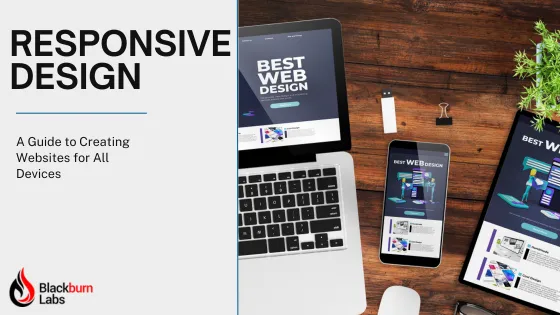Responsive Design: A Guide to Creating Websites for All Devices

In an era where the digital landscape is rapidly evolving, responsive web design has transitioned from a trend to a fundamental necessity. As of 2022, a staggering 58.99% of global website traffic was generated from mobile devices, excluding tablets. This shift towards mobile browsing underscores the critical need for websites to adapt to various screen sizes and user environments.
What is Responsive Web Design?
Responsive web design is building websites that ensure optimal viewing and interaction experiences across any device. The main goal is to create a website that adapts and responds to the user’s device, providing an excellent user experience regardless of screen size or orientation.
Examples and Applications
A common example is how navigation menus transform across different devices:
- Desktop: Horizontal menu bar with dropdown options
- Mobile: ‘Hamburger’ menu icon revealing a slide-out menu
- Tablets: Adaptive menu based on screen space
The Need for Responsive Design
1. Ubiquity of Mobile Devices
With mobile devices accounting for the majority of web traffic, having a responsive website is crucial for reaching your audience wherever they are.
2. Improved User Experience
Responsive design ensures that users have a seamless experience across all devices, reducing frustration and increasing engagement.
3. Google’s Mobile-First Indexing
Google now primarily uses the mobile version of websites for indexing and ranking, making responsive design essential for SEO.
4. Cost-Effective Solution
Rather than maintaining separate desktop and mobile sites, responsive design provides a single solution that works across all devices.
5. Accessibility for All
Responsive websites are more accessible to users with different needs and preferences, ensuring your content reaches the widest possible audience.
6. Future-Proofing Your Website
As new devices with varying screen sizes continue to emerge, responsive design ensures your website will adapt to future technologies.
How to Achieve Responsive Design
1. Use Fluid Grids and Flexible Layouts
Design your website using relative units like percentages instead of fixed pixel values, allowing elements to resize proportionally.
2. Implement Media Queries
Media queries allow you to apply different CSS styles based on device characteristics like screen width, helping you optimize the layout for different devices.
3. Create Flexible Images
Ensure images scale appropriately by using CSS to set maximum widths and allowing them to resize within their containers.
4. Adopt a Mobile-First Approach
Start designing for mobile devices first, then progressively enhance the experience for larger screens. This ensures core functionality works on all devices.
5. Thoroughly Test Across Devices
Test your website on various devices and screen sizes to ensure it works correctly and provides a good user experience everywhere.
Conclusion
Responsive web design is no longer a luxury; it’s a necessity in today’s market. With the majority of web traffic coming from mobile devices and Google’s mobile-first indexing approach, businesses must prioritize creating adaptable websites to reach broader audiences and provide excellent user experiences across all devices.
By following best practices and implementing responsive design principles, you can ensure your website meets the needs of modern users and positions your business for success in the digital landscape.